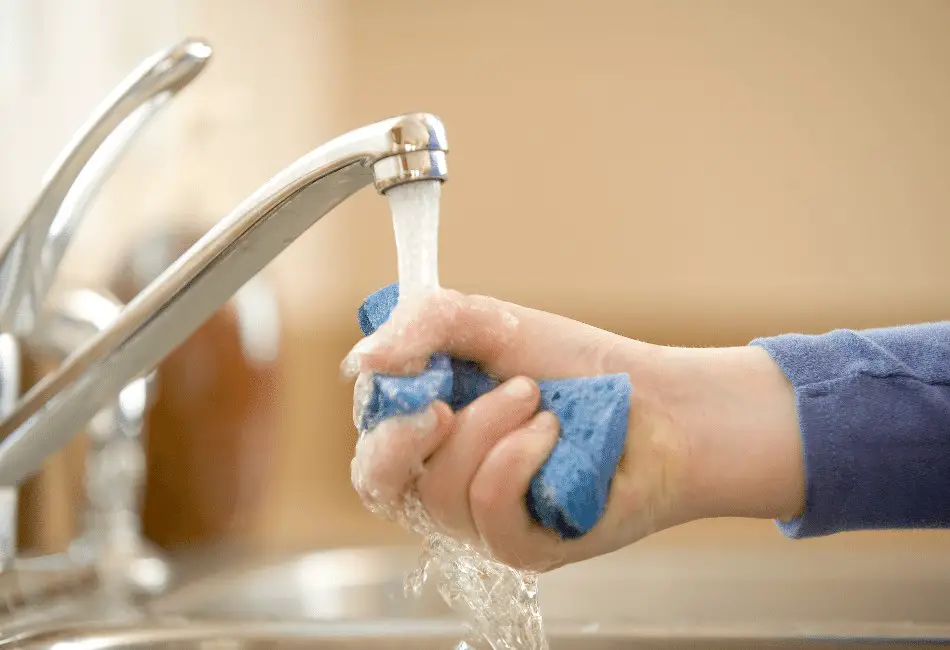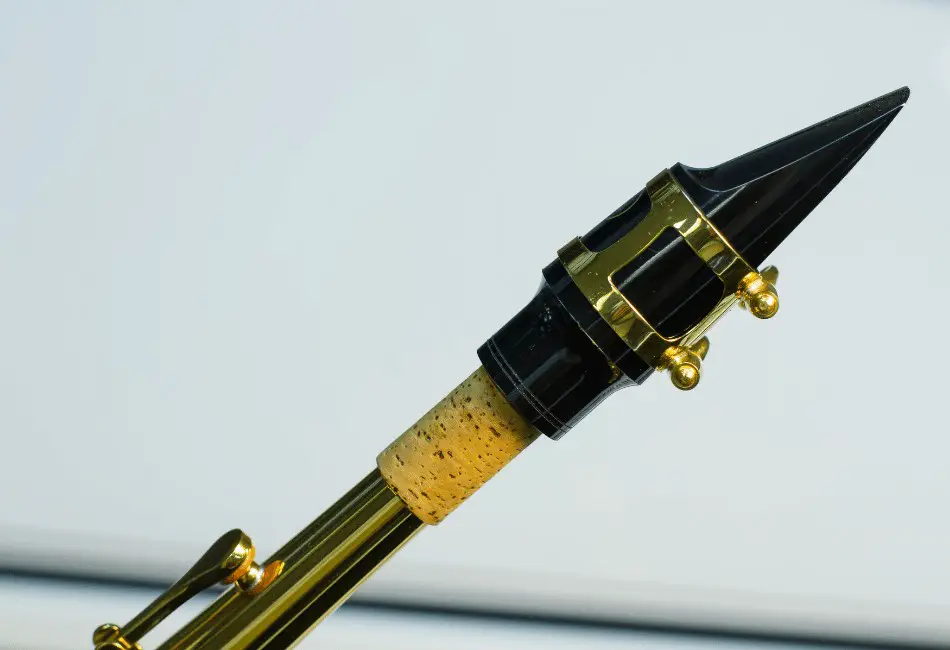Are you a new saxophone player or a parent of one?
Do you want to make sure the mouthpiece is sanitized completely?
With germs and pandemics and bacteria and general ickiness going around, knowing how to keep your instrument or your child’s wind instruments clean with proper hygiene is essential.
You don’t want to spread anything around, but you also need to ensure you don’t damage the instrument (and you will if you’re not careful).
Fortunately for you, we’ve got this process covered in this article.
Note: This method works for rubber mouthpieces, metal, and ebonite mouthpieces.
Table of Contents
What You’ll Need To Clean A Saxophone Mouthpiece
Here are the materials you’ll need:
- A small tub or bowl for water
- Soft toothbrush
- Simple sponge
- Towel or paper towel
- Cotton ball or cotton swab
- Lemon juice or white vinegar
- Toothpick
- Scissors
- Mouthwash
Alternatively, most of these things come pre-packaged for you in a simple and affordable saxophone cleaning kit.
I recommend these because it’s so easy to use, and you’ll be able to just keep it in your case.
Video On How To Clean A Saxophone Mouthpiece
Step By Step How To Clean A Saxophone Mouthpiece
Here are the steps for a saxophone mouthpiece deep clean.
Follow these directions to remove all calcium deposits and stuck-on bits of saliva moisture (as well as disinfecting).
Alternatively, if you want to just do a quick clean, feel free to do steps 1-5 and 10-11.
Note: This also works on a clarinet mouthpiece and other reed instruments.
#1 Let It Soak For 20 Minutes In Warm Water
The first step is simple: let’s give it a soak.
Soaking in lukewarm water will loosen up the stuck-on deposits and prepare them for scrubbing.
Plus, you won’t have to worry about chemicals.
Fill a small tub, bowl, or cup of water. You don’t want hot water, but get it as hot as possible while still being able to touch it easily.
Cold water is OK but not as effective. Cold water won’t loosen up the gunk as much.
Soapy water isn’t recommended at this step.
Take your mouthpiece off the neck and put it in (no reed or ligature).
Make sure it’s submerged. Let is soak for 20-30 minutes.
#2 Lightly Scrub With A Soft Brush Inside And Out
Take it out of the water and use a toothbrush to scrub all surfaces of the mouthpiece, inside and out.
Make sure to pay extra attention to any creases, seams, and areas where gunk gets even more stuck.
Don’t be afraid to use a little pressure to remove some of the stuff, but if it’s really stuck on, then you need to follow the next steps.
#3 Use A Sponge To Remove The Tough Spots
For big pieces of gunk and stuff stuck on the surface, grab a sponge and use some force. See if this at least wears off some of the gross things.
#4 Dry Them Off
Use kitchen towels or paper towels to dry the mouthpiece off.
If you’re not worried about a deep clean, skip ahead to step 10 now. If you want to make sure it’s as nice and clean as possible, keep going.
#5 Use A Cotton Ball For Another Removal
Take a piece of cotton ball and stick it fully inside the mouthpiece. Make sure the cotton ball is in contact with the entire interior.
Use a couple of cotton balls if you need to.
Take your lemon juice or white vinegar and soak the cotton ball with the liquid, wiping away any liquid dripping down the outside.
Find the happy medium between not quite dripping wet and yet more than a few drops.
Some special mouthpiece cleaners would be fine here too.
Don’t use other types of vinegar. White vinegar doesn’t cause discoloration.
By the way…
If you’re looking for affordable but awesome sax lessons online, I’d recommend checking out Udemy. The best option for new players is the Alto Saxophone Lessons for Beginners course.
#6 Let Soak For A Couple Of Hours
With the cotton ball or balls soaked, let the whole thing rest for a couple of hours. This acidic liquid will wear at the calcifications and gunk but not the hard rubber or metal mouthpieces.
#7 Give Another Scrub If Needed
Remove the cotton ball and use it to give a scrub to the areas you can reach. The gunk should be plenty loose now, so it won’t take much force.
Feel free to use a paper towel to dry off here, but you don’t have to.
#8 Run A Piece Of Cotton Through
For unreachable areas, take a toothpick and spear the cotton ball.
Put a few drops of your liquid on the ball and push it through the interior several times to make sure it gets any hard-to-reach gunk.
You may need to use scissors to cut the ball to a better size and shape.
A pipe cleaner will work, but pipe cleaners have metal inside them. It may scratch something.
Alternatively, a pre-packaged saxophone cleaning kit has a special mouthpiece brush designed for all this work. It really is easy to use.
#9 Rinse Off Lemon Juice
At this point, everything should be clean and free of debris.
Use cold running water to rinse off the lemon juice or white vinegar until there is none left.
#10 Disinfectant Soak
This is where we kill viruses and bacteria.
Fill your container up with mouthwash (not the kind with added sugar for kids) or some other alcohol-based liquid. Some players even use vodka!
It’s the alcohol we’re looking for since alcohol is a disinfectant. Isopropyl alcohol also works.
Hydrogen peroxide will do the job, but it’s a little harsh.
Dishwasher soap is also fine, but ensure you use soap and not detergent.
Let it soak for one minute.
#11 Rinse And Enjoy!
Give it one more rinse with lukewarm water, and enjoy! Dry with a paper towel or soft cloth and go.
Your saxophone or clarinet mouthpiece is now free of residue and super disinfected!
You may also want to wash your hands with soap when you’re done.

Commonly Asked Questions
What happens if you don’t clean your saxophone?
Without cleaning, gunk builds up from little particles in your saliva and moisture. Over time, these particles gather into quite big pieces, and bad things happen.
In some cases, your finish will be worn off. In worse cases, holes may be worn through the body of the sax.
Most commonly, your finger pads and cork will get worn and allow air to leak out, making your instruments unplayable.
How long will a saxophone last?
A sax should last a lifetime if cared for properly, including regular cleaning. For new players who end being serious about saxophones, you’ll want to upgrade from the beginner models to more advanced saxophones.
As far as functionality goes, cleaning once per week, deep cleaning once per month, and yearly checkups at a music store will have it last a long time, even forever.
Will alcohol wipes work for cleaning?
Alcohol wipes do work, but they aren’t as effective at removing high quantities of bacteria build-up inside the cracks and crevices.
This whole cleaning process, especially the soak, is critical for real disinfecting.
Final Thoughts
Clean your sax mouthpiece on a regular basis using these steps (or at least 1-5 and 10-11) to make sure it doesn’t wear down, get damaged, and become a breeding place for germs.
It’s easy to do and inexpensive for anyone to do, but it’s a critical part of instrument hygiene and saxophone care.
Avoid problems with musical instruments by cleaning them to prevent infections from instruments using our cleaning steps above.

